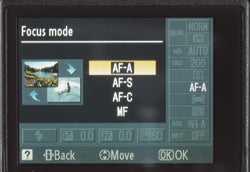Modern focusing systems are very sophisticated and there are lots of options to fine-tune it to suit your situation
For a subject to be recorded clearly, the camera’s lens needs to focus on it, and to do that the camera needs to know how far away it is. And in order to know that, it first needs to determine which, of all the elements in the scene, is the subject. It must do all this in fractions of a second, otherwise you’ll miss the shot.
Simple cameras feature a single focus point in the centre of the frame, but more sophisticated cameras employ multiple points around the frame to quickly identify and focus on the subject. This also makes it easier for the camera to detect moving subjects and even predict their trajectory.
Focus Modes

Single-Shot AF
For general photography of static subjects. The lens focuses and locks onto the subject when you press the shutter halfway. If your subject moves between focusing and shutter release in the meantime it may not be in focus.
Continuous AF
Use this for moving subjects. As long as your finger is on the shutter the lens will keep refocusing as required, and you can shoot at any time, even if the lens hasn’t focused yet. Most cameras use a Predictive AF system in this mode which, by analysing the speed of movement, can anticipate where the subject will be when you take the shot.

Continuous AF mode is best for photographing fast-moving subjects
Auto AF
In Auto AF mode the camera starts out in Single Shot AF mode but automatically switches to Continuous AF if it detects subject movement.
Manual Focus
Manual focus is ideal for situations where both the subject and camera are in fixed positions and you want to take multiple shots, or for when AF is unreliable (e.g. in low light).
Focusing Points
Multi-Point AF
Modern DSLRs employ multiple focusing sensors, arranged in a diamond formation around the frame, and outlined in your viewfinder. When your camera focuses, the active points usually light up red so you can see which area the camera has focused on – in most cases it’s whatever is closest. You can usually switch some of these points off and use smaller clusters or even a single point.

Multi-point AF systems are designed to ensure that it’s the boy, not the more centrally placed shrubs in the background, that the lens focuses upon

Multi-point AF is useful when the main subject is off-centre
Single-Point AF
Ideal for subjects that are generally in the centre of the frame, or when your main subject is not the closest to the camera. If your subject is off-centre you’ll need to use the focus lock. Point the focus point at the subject, then depress and hold the shutter button halfway (or press the AF lock button, on the back near your thumb) before recomposing to shoot.
Face Detection
Many modern cameras feature Face Detection, which is a form of AF in which the camera can recognise a face, or faces, in your scene which it then focuses on. Face Detection works very well, so if portraits and family snaps are a major part of your photography, it’s a good idea to ensure this feature is switched on in your menu.
Depth of Field
A camera can only focus on one plane of distance at a time. In addition there is an area in front of and behind the point focused on that appears sharp to the naked eye. This area is known as the Depth of Field (DoF).

The shallow depth of field here rendered only the closest subject in focus. To get both faces sharp would have required a greater depth of field
AF Assist Lamp
Many DSLRs feature a small lamp on the front of the camera to help the camera focus in low light, by projecting a patterned beam onto the subject for the AF to lock onto.
Focus Activation
With some cameras you can separate the focusing from the shutter button by assigning the focus to the AF lock button on the back. This is ideal for when you don’t want the camera to refocus every time you press the shutter but may randomly need to refocus at moments of your choosing. You’ll find this option in the set-up menu.





